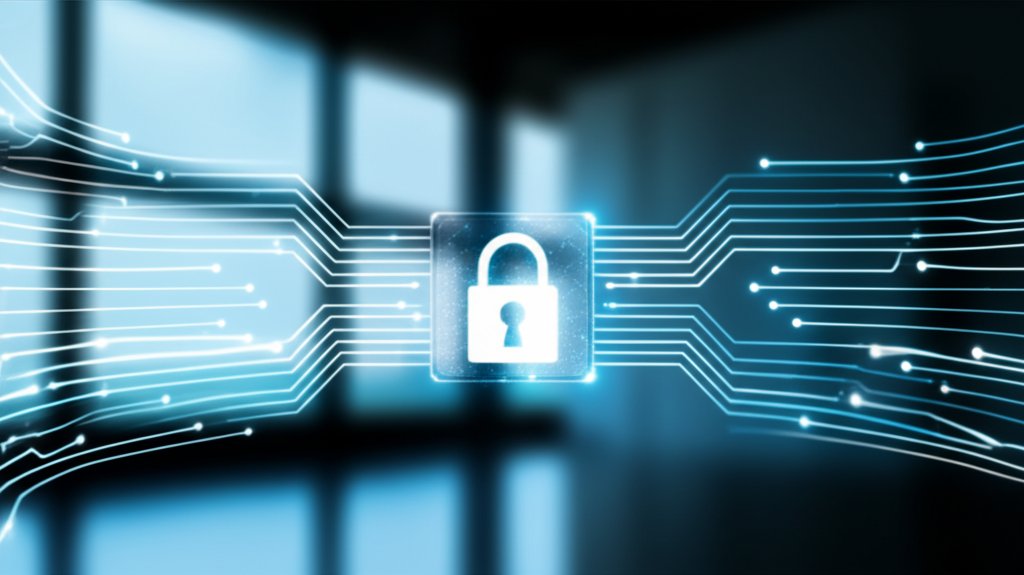Let’s talk about a stark reality: A significant percentage of all data breaches, often cited to be over 80% by reports like the Verizon Data Breach Investigations Report, can be traced back to compromised credentials – primarily passwords. This isn’t just an abstract statistic; it represents tangible risk to your personal finances, your identity, and the integrity of your small business operations. Our digital lives are interwoven with every facet of our existence, yet for many, the gatekeepers to this critical landscape remain antiquated passwords.
If you’re nodding along, having experienced the familiar frustration of forgotten passwords, the anxiety of a data breach headline, or the persistent worry that your online accounts are vulnerable, you’re not alone. The truth is, traditional passwords, no matter how complex, are no longer a sufficient defense against the sophisticated cyber threats we face daily. Automated attacks like credential stuffing, where stolen password lists are tried against millions of accounts, and highly convincing phishing campaigns make even “strong” passwords dangerously fragile.
But there’s a more robust, more convenient, and fundamentally safer path forward. This isn’t merely a technological advancement; it’s a critical paradigm shift: passwordless authentication. By leveraging modern cryptographic standards like FIDO2/WebAuthn and the inherent security features of your devices, passwordless authentication empowers you to take decisive control of your digital security. It’s a practical necessity in today’s threat landscape, moving us beyond the weakest link to truly safeguard our identities and assets.
In this comprehensive, step-by-step guide, I will demystify passwordless authentication. We’ll uncover why it’s not just superior but essential, break down the practical methods available, and, most importantly, provide you with clear, actionable steps to integrate it into your digital life. My aim is to equip you with the knowledge and confidence to transition to a more secure and remarkably effortless online experience.
What You’ll Learn
In this guide, you will gain the knowledge to:
- Understand the inherent flaws of traditional passwords and why they pose significant security risks in today’s digital environment.
- Grasp what passwordless authentication truly is and how it fundamentally enhances your online security posture.
- Identify the major benefits of adopting a passwordless approach for both your personal digital life and your small business operations.
- Explore a detailed breakdown of popular passwordless methods, including biometrics, advanced passkeys, magic links, and robust hardware security keys.
- Follow clear, actionable steps to begin enabling passwordless authentication on your devices and across your most important online services.
- Find answers to common concerns and frequently asked questions, empowering you to confidently embrace this innovative security paradigm.
Prerequisites
Before we delve into the practical steps, ensure you have the following readily available. Most are items you likely already use daily:
- A Modern Smartphone or Computer: Contemporary devices come equipped with essential features such as fingerprint scanners, facial recognition cameras, and secure enclaves, which are fundamental to most passwordless methods, especially passkeys.
- Access to Your Existing Online Accounts: You’ll need to log into your current email, banking, social media, and work-related accounts to modify their security configurations.
- An Up-to-Date Web Browser: Browsers like Chrome, Edge, Firefox, and Safari provide robust support for cutting-edge authentication standards like FIDO2/WebAuthn, which underpin passkey technology.
- Basic Familiarity with Device Settings: While we will guide you, a general understanding of how to navigate your phone’s or computer’s settings will be beneficial.
- A Willingness to Embrace Change: Transitioning from ingrained password habits can feel unfamiliar initially, but the long-term gains in security and convenience are undeniably substantial.
Time Estimate & Difficulty Level
Estimated Time: Plan for approximately 30-60 minutes for the initial setup on a few critical accounts. Fully adopting passwordless across all your services will be a gradual, ongoing process.
Difficulty Level: Beginner to Intermediate. While some underlying concepts may appear technical, the practical implementation steps are designed to be clear and manageable for any user.
Step 1: Understand the Password Problem: Why Traditional Passwords Fail
Before we can effectively implement solutions, we must squarely face the reality: traditional passwords are now the weakest link in your digital security chain. Despite decades of advice to create complex, unique passwords, the fundamental model is inherently flawed and highly vulnerable to modern attack vectors. Here’s why your passwords are no longer enough:
Weak Passwords & Pervasive Reuse
Human nature drives us to simplicity, leading many to choose easy-to-remember passwords or, critically, to reuse them across numerous online services. This common practice creates a catastrophic vulnerability: a single data breach on a minor website can instantly compromise dozens, if not hundreds, of your other accounts. Attackers actively exploit this ‘single point of failure’ with devastating efficiency.
Phishing & Credential Stuffing Attacks
Passwords are exquisitely susceptible to social engineering attacks like phishing, where malicious actors craft sophisticated fake websites to trick you into voluntarily revealing your login credentials. Beyond this, credential stuffing attacks are rampant. Cybercriminals automate processes to take vast lists of usernames and passwords stolen from one breach and attempt to log into countless other services, hoping for matches. Since passwords are reused, these automated attacks often succeed, giving attackers broad access to your digital identity.
User Frustration & Significant Organizational Cost
Beyond the security risks, the cognitive burden of constantly remembering, resetting, and managing strong, unique passwords for every service is immense. This leads to burnout and less secure practices. For small businesses, this user frustration translates directly into lost employee productivity and substantial IT support costs dedicated to resolving endless password reset requests, diverting resources from more strategic initiatives.
Instructions:
- Take a moment to honestly assess your own password habits. Do you, like many, find yourself reusing passwords or opting for simpler combinations?
- Recall the last time you had to reset a forgotten password. Beyond the annoyance, consider the time it consumed and the brief vulnerability you might have felt.
Conceptual Vulnerability Example:
# Imagine a password easily guessed or cracked:
password_example = "Summer2024!" # Often predictable and vulnerable to dictionary or brute-force attacks. # Illustrating the danger of password reuse across services: user_account_personal = { username: "your_email@example.com", password: "MySecurePassword123!" } user_account_work = { username: "your_email@work.com", password: "MySecurePassword123!" } # If the database for your personal account is breached, the exact same password # can immediately be used to access your critical work account.
Expected Outcome: A clear and critical understanding of why traditional passwords are a profound security risk and an outdated defense mechanism.
Step 2: Grasp the Core Concept of Passwordless Authentication
Having understood the inherent fragility of passwords, let’s now define the robust alternative. Passwordless authentication is fundamentally a method of verifying your digital identity without requiring you to input or remember a traditional password. It represents a paradigm shift from “something you know” to relying on “something you have” (like your trusted smartphone, computer, or a hardware security key) or “something you are” (such as your unique fingerprint or facial features).
Instructions:
- Internalize that the primary objective of passwordless authentication is the complete elimination of the password as the foundational authentication factor.
- Recognize that this critical shift leverages device-bound cryptographic identifiers or inherent biometric traits for secure verification, making it inherently more resistant to common attacks.
Conceptual Authentication Flow:
// Traditional Password Flow:
// 1. Server asks: "Please provide your password." // 2. User responds: "mySecretPassword123!" // 3. Server checks: "Does 'mySecretPassword123!' match our stored hash? Yes/No." // Passwordless Flow (e.g., using a Passkey): // 1. Server asks: "Authenticate with your registered device." // 2. User's device (e.g., smartphone) prompts for a fingerprint or face scan. // 3. Upon successful biometric verification (locally on the device), the device generates // a unique cryptographic signature using its private key, and sends it to the server. // 4. Server verifies the signature using the pre-registered public key (the password itself // is never transmitted or stored on the server). // 5. Server confirms: "Signature verified! Access granted."
Expected Outcome: A foundational understanding of the principles behind passwordless login and its critical distinction from traditional password-based methods.
Step 3: Recognize the Transformative Benefits of Going Passwordless
Adopting passwordless authentication is not merely a security upgrade; it’s a strategic move to fundamentally enhance both your personal digital life and your small business operations. The advantages extend far beyond simply eliminating passwords:
Unparalleled Enhanced Security
Passwordless methods inherently and dramatically diminish the attack surface. There is no password to be phished, no credential to be stolen during a data breach, and no weak link for brute-force or credential stuffing attacks. This is a profound game-changer for safeguarding your most sensitive personal data and critical business information against today’s most prevalent cyber threats.
Significantly Improved User Experience
Imagine logging into your accounts with a simple glance or a touch, without the cognitive load or repetitive friction of typing complex strings. Passwordless authentication is demonstrably faster, far more convenient, and eliminates the frustration of remembering, forgetting, and constantly resetting passwords. Your online interactions become seamless, intuitive, and remarkably efficient.
Substantially Reduced IT Burden (Especially for Small Businesses)
For small business owners and their teams, the operational benefits are significant. Fewer password reset tickets translate directly into increased productivity, allowing employees to focus on their core responsibilities rather than administrative security hurdles. It simplifies user account management and bolsters your organization’s overall cybersecurity posture without demanding advanced technical expertise from your staff.
Strategic Future-Proofing
Embracing passwordless authentication, particularly through robust methods like passkeys built upon the FIDO2/WebAuthn open standards, positions you at the forefront of modern cybersecurity practices. This strategic adoption ensures your digital identity and infrastructure are aligned with the most resilient and evolving security frameworks available, preparing you for future digital challenges.
Instructions:
- Reflect on which of these profound benefits most directly addresses your current online security pain points or operational inefficiencies.
- Consider how the practical application of a passwordless approach could not only streamline your daily logins but also provide a new level of confidence and peace of mind in your digital interactions.
Conceptual Security Advantage:
# With traditional passwords:
stolen_passwords_list = ["user1:passA", "user2:passB", "user3:passC"] # Attackers can automate attempts to use these credentials on countless other websites. # With passwordless authentication (e.g., passkeys): # No password data is ever stored on the server that can be compromised and reused. # Authentication relies on cryptographically signed challenges unique to your device and session. # This fundamental design prevents credential stuffing and large-scale phishing attacks entirely.
Expected Outcome: A compelling and practical motivation to actively transition towards passwordless authentication, driven by its undeniable advantages in security, usability, and operational efficiency.
Step 4: Explore Popular Passwordless Authentication Methods
Now that we understand the “why,” let’s dive into the “how.” Going passwordless involves various practical methods, each offering distinct levels of security, convenience, and applicability. Familiarizing yourself with these options will enable you to make informed decisions for your digital security.
Biometrics (Fingerprint, Face ID)
This is likely the most universally familiar form of authentication. Your unique physical characteristics are employed to verify your identity. While your smartphone routinely uses biometrics for device unlock, for online accounts, biometrics are typically integrated with other robust methods (like passkeys) rather than being the sole authentication factor transmitted directly over the internet.
- How it works simply: Your device securely scans your fingerprint or face, compares it against a cryptographic template stored exclusively on the device itself (this data never leaves your device). If a match is confirmed, the device then authorizes access or a login request, without exposing your raw biometric data.
- Pros: Exceptionally convenient, offers high security as your biometric data remains local and protected by the device’s secure enclave.
- Cons: Device dependence means you need a recovery strategy if your primary device is lost or inaccessible. While secure, some users have initial privacy concerns, which modern implementations address by keeping data local.
Passkeys (FIDO2/WebAuthn) – The Gold Standard
Passkeys are rapidly emerging as the gold standard for passwordless authentication, designed specifically to be phishing-resistant cryptographic login credentials that completely replace traditional passwords. Built upon open industry standards (FIDO2/WebAuthn), they are engineered for seamless and secure operation across different devices and platforms.
- How it works simply: When you create a passkey for a website, your device generates a unique, cryptographically linked key pair: a public key and a private key. The public key is securely registered with the website, while the private key is held securely on your device (often further protected by your device’s biometric or PIN). To log in, your device uses this private key to cryptographically prove your identity to the website without ever revealing the private key itself. Crucially, passkeys can securely sync across your devices (e.g., via iCloud Keychain, Google Password Manager), offering both convenience and resilience.
- Pros: Offers exceptional security, inherently phishing-resistant, provides excellent cross-device and cross-platform functionality, and significantly enhances user experience.
- Cons: As a newer technology, broader website adoption is still expanding, though it is rapidly becoming mainstream.
Magic Links (Email Authentication)
With magic links, the authentication paradigm shifts from memorized credentials to your email inbox. Instead of typing a password, you receive a unique, time-sensitive link in an email, which, when clicked, logs you directly into your account.
- How it works simply: You initiate a login by entering your email address. The service then dispatches an email containing a special, single-use link. Clicking this link securely authenticates your session.
- Pros: Extremely straightforward and easy to use, entirely removes the need to remember any password.
- Cons: The security of magic links is directly tied to the security of your email account. If your email is compromised, so are your magic link-protected accounts. Additionally, there can be minor delays due to email delivery latency.
One-Time Passcodes (OTP) via Authenticator Apps
While frequently deployed as a second factor in Multi-Factor Authentication (MFA), One-Time Passcodes (OTPs) can also serve as a form of passwordless authentication when no initial password is required. OTPs generated by authenticator apps offer a significantly higher level of security than SMS-based OTPs.
- How it works simply: You begin a login process, and a temporary, time-sensitive code is either sent to your phone via SMS (less secure) or, preferably, generated by a dedicated authenticator app (like Google Authenticator, Microsoft Authenticator, or Authy). You then enter this code to gain access.
- Pros: When using authenticator apps, this method adds a very strong layer of security. It is widely available across many services.
- Cons: SMS OTPs are vulnerable to SIM swapping attacks. While authenticator app OTPs are strong, they still require you to physically enter a code, which is a step away from true seamless passwordless experience like passkeys.
Hardware Security Keys (e.g., YubiKey, Google Titan Key)
For the highest echelon of security, hardware security keys are physical devices designed to provide robust authentication. These keys typically connect to your computer via a USB port or wirelessly through NFC or Bluetooth.
- How it works simply: When prompted during login, you either insert the key into a port or tap it to a compatible device. The key then cryptographically verifies your identity to the service, leveraging highly secure, tamper-resistant hardware.
- Pros: Offers one of the strongest forms of phishing resistance available, is portable, and does not rely on your device’s battery for its core function.
- Cons: Requires the purchase and physical carriage of the key(s). While recovery options exist, the potential for loss necessitates a strategy for backups.
Instructions:
- Familiarize yourself thoroughly with the distinct pros and cons of each method described.
- Identify which of these methods you might already be implicitly using (e.g., Face ID for unlocking your phone) as a potential stepping stone.
Conceptual Key Pair for Passkeys:
# Simplified representation of the cryptographic key pair used in passkeys:
# The 'private key' is securely stored and never leaves your device: private_key_device = "---BEGIN FIDO_PRIVATE_KEY---[highly complex, unique cryptographic string]---END FIDO_PRIVATE_KEY---" # The 'public key' is registered with the online service you're logging into: public_key_service = "---BEGIN FIDO_PUBLIC_KEY---[another complex, unique cryptographic string]---END FIDO_PUBLIC_KEY---" # During login, your device uses its 'private_key_device' to sign a unique challenge # issued by the service. The service then uses its stored 'public_key_service' to verify # that signature. The private key remains secure and confidential on your device.
Expected Outcome: A comprehensive understanding of the various types of passwordless authentication methods and their underlying security mechanisms, enabling informed choice.
Step 5: Differentiating Passwordless Authentication from Multi-Factor Authentication (MFA)
It’s common to conflate passwordless authentication with Multi-Factor Authentication (MFA) or Two-Factor Authentication (2FA), so a precise clarification is essential. MFA, at its core, mandates the use of two or more distinct categories of authentication factors to verify your identity. These factors are universally categorized as:
- Something You Know: This includes traditional passwords, Personal Identification Numbers (PINs), or security questions.
- Something You Have: This encompasses physical possessions like your smartphone, a dedicated hardware security key, or an authenticator app.
- Something You Are: This refers to unique biological traits, such as a fingerprint scan or facial recognition.
Traditional MFA typically involves combining “something you know” (your password) with an additional factor (like a One-Time Passcode sent to your phone). True passwordless authentication, however, fundamentally eliminates the “something you know” factor entirely. It achieves robust security by relying solely on combinations of “something you have” and “something you are,” or by employing a single, inherently strong factor such as a passkey. Therefore, while passwordless is undeniably a form of highly secure authentication, its defining characteristic is the complete removal of the password requirement.
Instructions:
- Grasp the critical distinction: MFA adds layers of security around your password, whereas passwordless authentication entirely removes the password as an authentication factor.
- Understand that many modern passwordless methods, particularly passkeys, inherently integrate multiple factors (e.g., your device as “something you have” protected by your biometric as “something you are”).
Expected Outcome: A clear and unambiguous understanding of the difference between passwordless authentication and traditional Multi-Factor Authentication.
Your Step-by-Step Guide to Adopting Passwordless Authentication
Alright, the theoretical groundwork is laid; it’s time to translate understanding into action! This practical guide will walk you through the process of securing your digital identity with passwordless authentication, one manageable step at a time.
Step 6: Methodically Assess Your Current Online Accounts
Brief explanation: Before initiating any changes, establish a clear understanding of your current digital footprint. This audit is crucial for prioritizing your efforts and identifying your most vulnerable points.
Instructions:
- Create a comprehensive list of all your significant online accounts. Focus particularly on those holding sensitive personal or business information:
- Primary email providers (e.g., Gmail, Outlook, ProtonMail)
- Banking and financial institutions
- Social media platforms (e.g., Facebook, Instagram, LinkedIn, Twitter/X)
- Mission-critical work-related applications and platforms (e.g., Slack, Microsoft 365, Google Workspace, CRM systems)
- Online shopping and payment services (e.g., Amazon, PayPal, Stripe)
- For each account, objectively assess its sensitivity level (e.g., Critical, High, Medium) and note its current authentication method.
Conceptual Account Audit Example:
# Think of this as creating a personal or business security inventory:
# --------------------------------------------------------------------------------- # Account Type | Service Name | Sensitivity Level | Current Authentication # --------------------------------------------------------------------------------- # Email | Gmail | Critical | Password + SMS OTP # Banking | Bank of America | Critical | Password + App OTP # Social Media | LinkedIn | Medium | Password Only # Work CRM | Salesforce | High | Password + SMS OTP # Online Shopping| Amazon | Medium | Password Only # ---------------------------------------------------------------------------------
Expected Outcome: A clear, prioritized inventory of your online accounts, highlighting those most crucial for immediate passwordless adoption.
Tip: Even if temporary, a reputable password manager can assist in providing an overview of all the accounts you currently manage with passwords.
Step 7: Verify Passwordless Authentication Support for Each Service
Brief explanation: While passwordless technology is advancing rapidly, not every service has fully implemented all options. You need to identify where you can begin making the switch immediately.
Instructions:
- Log into each of your prioritized accounts from the previous step.
- Navigate directly to their security settings. Look for sections typically labeled “Login Options,” “Security,” “Two-Factor Authentication (2FA),” “Multi-Factor Authentication (MFA),” or specifically “Passwordless.”
- Within these settings, specifically search for and note options such as:
- “Passkeys” or “FIDO security key” (this is the top priority)
- “Biometric login” (often seamlessly integrated with passkeys or device unlock features)
- “Sign in with Google/Apple/Microsoft” (these identity providers often offer robust passwordless options themselves)
- “Authenticator App” setup (for Time-based One-Time Passcodes – TOTPs)
- “Email Magic Link” options (less common for highly critical services, but still passwordless)
- Document which passwordless methods are available for each service.
Conceptual User Interface Example:
# On a website's security settings page, you might encounter a similar interface:
<div class="security-option"> <h3>Primary Login Method</h3> <ul> <li><input type="radio" name="login_method" value="password" checked> Use Password</li> <li><input type="radio" name="login_method" value="passkey"> <strong>Enable Passkey</strong> <span class="new-badge">Recommended</span></li> <li><input type="radio" name="login_method" value="biometric"> Biometric Login (Fingerprint/Face)</li> <li><input type="radio" name="login_method" value="magic_link"> Email Magic Link</li> </ul> <button onclick="saveSecuritySettings()">Save Changes</button> </div>
Expected Outcome: A clear understanding of which of your critical online accounts currently support specific passwordless authentication options.
Step 8: Strategically Prioritize High-Value Accounts for Immediate Transition
Brief explanation: It’s neither practical nor necessary to switch all your accounts simultaneously. Focus your initial efforts where the impact of a breach would be most severe.
Instructions:
- Direct your initial passwordless adoption efforts towards your absolute most critical accounts. This includes your primary email provider, all banking and financial institutions, and any mission-critical applications vital to your small business operations. Compromise of these accounts carries the highest risk and most severe potential consequences.
- For these high-value accounts, aim to enable the strongest available passwordless method. This typically means passkeys or robust app-specific biometric logins, which offer the highest levels of phishing resistance and convenience.
Conceptual Prioritization Strategy:
# A practical approach to prioritizing your passwordless implementation:
# ---------------------------------------------------------------------------- # Service | Value Level | Best Passwordless Option | Status # ---------------------------------------------------------------------------- # Primary Email | Critical | Passkey | Pending Setup # Personal Bank | Critical | Passkey / App Biometric | Pending Setup # Business CRM | High | Passkey / SSO Integration | Researching # Social Media | Medium | Authenticator App OTP | Future Step # ----------------------------------------------------------------------------
Expected Outcome: A focused, manageable plan identifying which critical accounts to secure first with passwordless authentication.
Step 9: Activate Biometrics and Passkey Support on Your Core Devices
Brief explanation: Your devices serve as the secure foundation for many passwordless authentication methods. Ensuring your biometrics and device-level passkey capabilities are active is a fundamental first step.
Instructions (General Guidelines):
- For Smartphones and Tablets (iOS/Android):
- Navigate to your device’s “Settings” menu. On iOS, look for “Face ID & Passcode” or “Touch ID & Passcode.” On Android, search for “Security & privacy” then “Biometrics.”
- Confirm that Face ID, Touch ID, or Fingerprint Unlock is properly enabled. These features are often used to secure and unlock your locally stored passkeys and facilitate app-specific biometric logins.
- For Computers (Windows/macOS):
- Windows: Go to “Settings” > “Accounts” > “Sign-in options.” Set up “Windows Hello Face,” “Fingerprint,” or establish a strong PIN, which can act as a local biometric equivalent.
- macOS: Access “System Settings” > “Touch ID & Password.” Enable Touch ID for user login and authorizing purchases.
- Create Your First Passkey for a Major Account (e.g., Google, Apple, Microsoft):
- Go to the security settings of a major service you use (e.g., for Google: your Google Account > Security > “How you sign in to Google” > “Passkeys”).
- Follow the prompts to initiate passkey creation. This typically requires a one-time verification of your identity using your current password or an existing MFA method.
- You will then be asked to use your device’s biometric (fingerprint/face) or PIN to securely save the new passkey.
- Once successfully created, you can log in to that service on supporting devices using only your device’s biometric or PIN, completely bypassing the need for a password.
Conceptual Passkey Creation Event:
# When you initiate passkey creation for an online service, a sophisticated,
# secure cryptographic exchange occurs behind the scenes. Conceptually: { "passkey_creation_request": { "relyingPartyId": "example.com", // The domain of the website (relying party) "challenge": "random_server_generated_string", // A unique cryptographic challenge "user": { "id": "base64_encoded_user_identifier", "name": "your_email@example.com", "displayName": "Your Name" }, "publicKeyCredentialParameters": [ /* supported cryptographic algorithms */ ] }, "device_response": { "attestationObject": "...", // Cryptographic proof that a valid credential was created "clientDataJSON": "..." // Data confirming the browser context and challenge verification } } # This complex data exchange culminates in a simple, secure biometric scan for you.
Expected Outcome: Biometrics successfully configured on your primary devices, and at least one passkey established for a major online service, providing a tangible experience of passwordless login.
Pro Tip: After setting up a passkey, log out of that service and immediately try logging back in using only your newly created passkey. This direct experience will highlight its seamless convenience!
Step 10: Implement Authenticator Apps for OTPs (Where True Passwordless is Absent)
Brief explanation: For online services that have not yet fully embraced true passwordless options like passkeys, leveraging an authenticator app for Time-based One-Time Passcodes (TOTPs) is a significantly stronger and more secure alternative than relying on SMS-based codes. It represents an excellent interim step toward a fully passwordless future.
Instructions:
- Download a Reputable Authenticator App: Install an authenticator app such as Google Authenticator, Microsoft Authenticator, Authy, or Duo Mobile on your smartphone.
- Enable Authenticator App for Your Accounts:
- Access the security settings of any accounts that support Multi-Factor Authentication (MFA).
- Look for an option explicitly labeled “Set up authenticator app,” “TOTP,” or “Time-based One-Time Password.”
- You will typically be presented with a unique QR code. Use your chosen authenticator app to scan this QR code.
- The app will then instantly begin generating a 6-digit code that refreshes automatically every 30-60 seconds.
- Enter this current code back into the website’s prompt to confirm and finalize the setup.
- Crucial: Always locate and securely save any provided recovery codes in a safe, offline location (e.g., printed out and stored in a highly secure, physical safe). These are your lifeline if you lose your phone.
Conceptual TOTP Generation:
# When setting up an authenticator app, the service securely shares a 'secret key'
# (often embedded within the QR code you scan). # Your authenticator app then uses this secret key to generate Time-based One-Time Passwords (TOTP). # The TOTP Algorithm (conceptual, simplified): # OTP = HASH(secret_key + current_time_interval) MOD 1,000,000 # The 'current_time_interval' is a segment of time that typically changes every 30 seconds, # ensuring the code is constantly refreshed and valid only for a short window.
Expected Outcome: Several of your online accounts will now be secured with robust authenticator app-generated OTPs, providing a stronger layer of protection where full passwordless is not yet available.
Step 11: Evaluate Hardware Security Keys for Pinnacle-Level Security
Brief explanation: For your most critical accounts, or for securing sensitive small business logins, hardware security keys represent the strongest available defense against phishing and other advanced attacks. These are physical, tamper-resistant devices that serve as an immutable authentication factor.
Instructions:
- Acquire a FIDO-Certified Security Key: Invest in a reputable, FIDO-certified security key from brands like YubiKey or Google Titan Key. Ensure the connectivity type (e.g., USB-A, USB-C, NFC, Bluetooth) is compatible with your primary devices.
- Register the Key with Supporting Services:
- Navigate to the security settings of online services that explicitly support FIDO security keys (e.g., Google, Microsoft, GitHub).
- Look for an option labeled “Security Key,” “FIDO Key,” or similar.
- Follow the on-screen instructions to register your key. This process typically involves physically inserting the key into a port or tapping it to an NFC reader when prompted.
- Strong Recommendation: Purchase at least two hardware keys – one as your primary and one as a readily accessible backup. Store the backup key in a separate, highly secure, offline location (e.g., a home safe or safety deposit box) to mitigate the risk of loss or damage to your primary key.
Conceptual Key Registration Process:
# While this step involves physical interaction rather than user-entered code,
# the underlying system must recognize and securely communicate with the key. # Example of an operating system-level rule (Linux UDEV) to allow interaction: # SUBSYSTEM=="usb", ATTR{idVendor}=="1050", ATTR{idProduct}=="0407", MODE="0660", GROUP="plugdev" # This type of system configuration ensures that your operating system has # the necessary permissions to securely communicate with a hardware security key like a YubiKey.
Expected Outcome: A hardware security key successfully registered to at least one of your most critical online accounts, providing the highest grade of phishing-resistant authentication.
Step 12: Champion Passwordless Adoption Within Your Small Business Team
Brief explanation: If you oversee a small business, the collective security posture of your team is paramount. Implementing passwordless authentication company-wide can drastically reduce your organization’s overall cyber risk and enhance operational efficiency.
Instructions:
- Proactively Communicate the Strategic Benefits: Clearly articulate to your team why transitioning to passwordless is a critical imperative for business security, and how it will simplify their daily login workflows, reducing friction and frustration.
- Provide Practical, Hands-On Training: Conduct training sessions that walk your team through the step-by-step process of setting up passkeys, biometrics, or authenticator apps for their essential work accounts (e.g., business email, CRM, project management tools, cloud storage).
- Establish Clear Security Policies: Implement and enforce clear organizational policies that mandate or strongly encourage the adoption of passwordless methods for all business-critical accounts, providing the necessary tools and support.
- Develop Robust Recovery Procedures: Crucially, ensure every team member understands the established procedures for account recovery in the event of a lost device or compromised security key, minimizing downtime and security exposure.
Expected Outcome: A more secure and cyber-aware business team that actively understands, adopts, and benefits from passwordless authentication methods.
Step 13: Cultivate a Habit of Regular Security Review
Brief explanation: The cybersecurity landscape is dynamic and continuously evolving. Maintaining vigilance through periodic review of your security configurations is an ongoing commitment, not a one-time task.
Instructions:
- Periodic Account Audits: Every few months, dedicate time to revisit the security settings of your most important online accounts.
- Seek New Opportunities: Actively look for any newly introduced passwordless authentication options that services may have rolled out since your last review.
- Stay Informed: Remain updated on the latest cybersecurity best practices, emerging threats, and advancements in passwordless technologies to continuously refine your security posture.
Expected Outcome: An ingrained practice of proactively maintaining and continuously enhancing your passwordless security strategy.
Expected Final Result
By diligently following these steps, you will have successfully embarked on a journey towards a fundamentally more secure and streamlined passwordless digital existence. You should now confidently possess:
- Your most critical accounts robustly secured with advanced passwordless methods, such as passkeys or strong authenticator app-based One-Time Passcodes.
- A clear, practical understanding of how various passwordless authentication methods function and their respective strengths.
- Enhanced peace of mind, knowing your digital identity is significantly better protected against common and sophisticated cyber threats.
- A remarkably more convenient and frictionless login experience, liberating you from the constant burden and frustration of complex, vulnerable passwords.
Troubleshooting Common Concerns & FAQs
It is entirely normal to have practical questions and concerns when embracing new security technologies. Here are answers to common “what ifs” to empower your transition:
“What if I lose my device that holds my biometric data or passkeys?”
- Solution: This is a paramount concern, and robust recovery options are built into the system.
- For passkeys that securely sync across your devices (e.g., via Apple iCloud Keychain or Google Password Manager), losing one device does not equate to losing access. You can simply use another synced device to authenticate.
- Most services supporting passkeys or hardware keys also provide critical backup recovery codes or alternative login pathways (such as a trusted email or phone number) as secure fallbacks. It is imperative that you save these recovery codes offline in a highly secure, private location.
- For hardware security keys, the strongest recommendation is to acquire and register at least two keys – one primary and one backup.
“Is my biometric data stored securely?”
- Solution: Absolutely. On modern devices, your biometric data (e.g., fingerprint, facial scan) is stored in a highly secure, isolated hardware component known as a “secure enclave.” This sensitive data never leaves your device and is never transmitted over the internet. Only a cryptographically signed confirmation that “you are you” is sent to online services, not your actual biometric image or template.
“Are magic links and OTPs considered truly passwordless, and are they secure enough?”
- Solution: Magic links are indeed a form of passwordless authentication as they eliminate the memorized password. One-Time Passcodes (OTPs), when used as the sole factor (without an accompanying password), also fall under the passwordless umbrella. However, their security is directly contingent on the robustness of your email account or phone number, which can be vulnerable to phishing or SIM swapping. Passkeys and hardware keys offer a significantly higher degree of phishing resistance. Consider magic links and authenticator app OTPs as excellent transitional steps or for securing less critical accounts.
“What about older online services that don’t yet support passwordless authentication?”
- Solution: For services that have not yet integrated modern passwordless authentication methods, continue to employ best practices: utilize strong, unique passwords generated and stored by a reputable password manager. Crucially, enable Multi-Factor Authentication (MFA) using an authenticator app (not SMS) wherever it is available. This combination provides the highest level of security until those services inevitably catch up.
What You Learned
You have now completed a significant and empowering step towards securing your digital identity! We meticulously explored the inherent and critical flaws of traditional passwords, clarifying why they are no longer adequate in today’s sophisticated threat landscape. You now possess a comprehensive understanding of what passwordless authentication entails, its profound benefits for both personal convenience and small business security, and a detailed overview of the various methods available, from biometrics and state-of-the-art passkeys to magic links and highly secure hardware keys.
Most importantly, you are now equipped with a practical, step-by-step guide to confidently implement these advanced security measures into your own online life. You are empowered to shed the burden of password headaches and embrace a demonstrably safer, more streamlined, and ultimately more enjoyable digital experience.
Next Steps
Your journey to a fully passwordless future is an ongoing process of continuous improvement and vigilance. Here’s how to proceed:
- Implement Gradually: Avoid the pressure to go fully passwordless overnight. Strategically start with your highest-value accounts and progressively extend to others as services roll out expanded support for passwordless options.
- Remain Informed: Make it a habit to regularly check the security settings of the services you use. As passwordless technology matures, more platforms will integrate these superior authentication methods.
- Educate and Empower Others: Share your newly acquired knowledge and practical insights with your friends, family, and colleagues. Help them understand and adopt these critical steps to secure their own digital identities.
- Explore Advanced Options: For those with critical business or elevated security needs, delve deeper into enterprise-level identity management solutions that are at the forefront of leveraging passwordless technologies.
Are you ready to experience the tangible difference passwordless authentication can make? Take the first decisive step today and begin securing your digital identity. We value your insights – please share your results and experiences in the comments below! And don’t forget to follow our blog for more practical cybersecurity tutorials and expert insights designed to keep you safe and resilient online.









